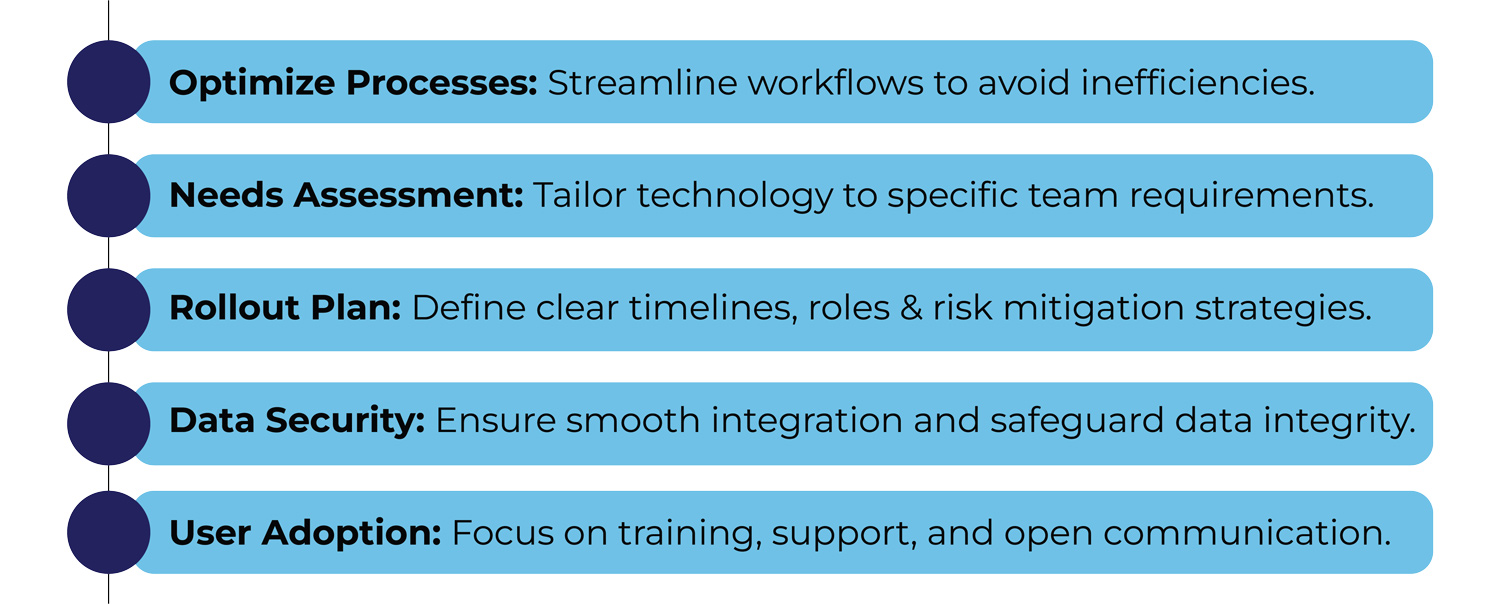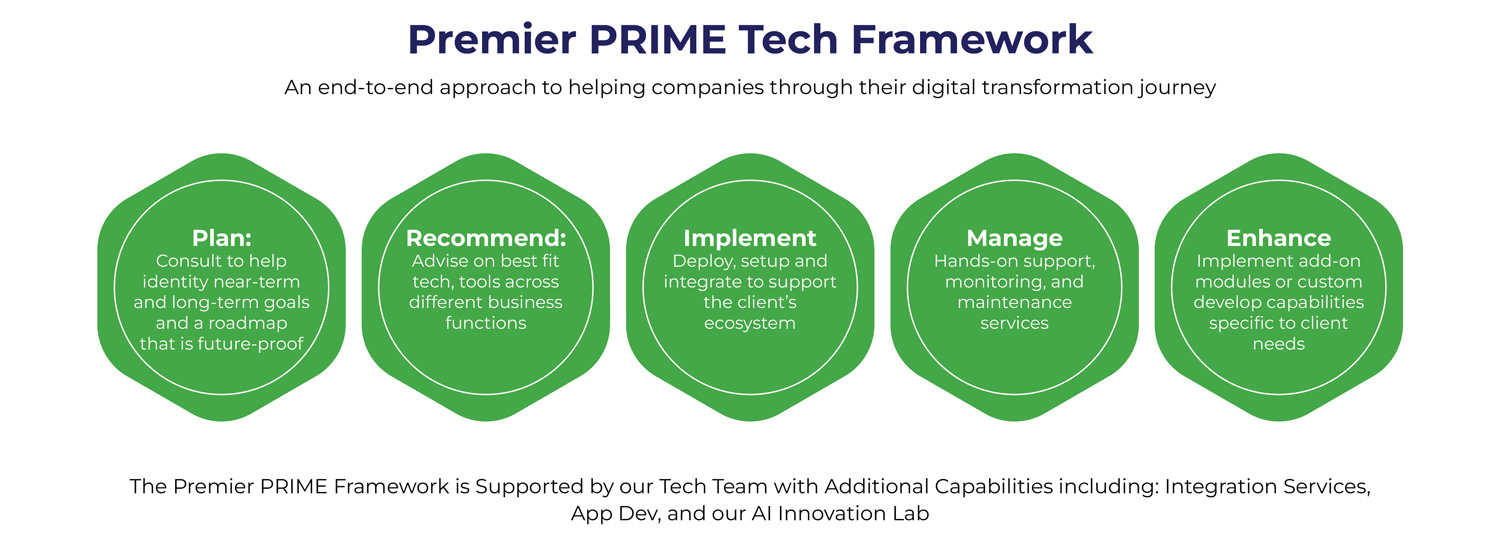New technology should empower your team, streamline processes, and fuel growth—not add complexity. Yet, research shows that nearly 70% of technology rollouts fall short of expectations.1 Why? Often, it’s due to a lack of alignment between the rollout plan and the organization’s needs, poor change management, or missing key IT rollout strategies.
“Technology is best when it brings people together.”
Matt Mullenweg
At its core, technology implementation is more than just deploying new systems or software—it’s about unlocking potential, creating competitive advantage, and driving true business transformation. But to achieve that vision, organizations must navigate budget considerations, integration hurdles, and cultural dynamics with a holistic and strategic approach.
So, what’s the key to a successful IT rollout? It starts with a carefully crafted rollout plan that aligns with your broader business goals and puts people first.
In this blog, we’ll explore how to ensure a seamless, successful technology rollout for your organization. From organizational readiness to key rollout steps, data-driven decision-making, and the strategic role of a trusted partner, you’ll discover how to turn new tools into powerful assets for growth.
Key Takeaways
- 1
- 2
- 3
- 4
- 5
- 6
The Strategic Importance of Technology Rollouts

Numerous businesses struggle with outdated technology, leading to operational disruptions and missed opportunities. It’s a scenario no organization wants to face. In the real world, failing to modernize or adopt the right technology can result in lost revenue, decreased productivity, and disengaged employees.
A well-planned technology implementation is not merely a technical project—it’s a business growth strategy. When aligned with your organizational goals, a strategic IT rollout can unlock new pathways for innovation, improve customer experiences, and fuel operational efficiency.
A report from McKinsey & Company reveals that 25% to 40% of technology programs exceed budgets or schedules by more than 50%, underlining the importance of rigorous planning and execution.2
The Complexity of Technology Rollouts
When technology rollouts fail, the reasons are rarely straightforward. From unclear objectives and poor change management to vendor issues and excessive customization, each factor plays a role. What’s more, many leaders underestimate just how intricate these initiatives are.
A recent study by Boston Consulting Group found that over 55% of companies struggle with managing the interdependencies of tech projects, leading to costly delays and budget overruns.3 This highlights that success isn’t about quick fixes or the latest tool—it’s about recognizing and managing the full complexity.
Ultimately, technology rollouts demand more than a systems integrator or a new platform. They require a coordinated effort across strategy, data, process, and people—each domain demanding focused attention to turn plans into real-world success.
What are 5 Key Steps for a Successful Technology Rollout?

1. Optimize Processes Before Automating
Before introducing new technology, it’s essential to evaluate and streamline existing workflows. Automating inefficient processes can amplify existing issues rather than resolve them. By identifying and addressing bottlenecks or redundancies beforehand, organizations ensure that the new technology enhances efficiency rather than complicating operations.
2. Conduct a Targeted Needs Assessment
Understanding the specific requirements of different departments and stakeholders is crucial. A tailored approach ensures that the technology aligns with the unique challenges and objectives of each team. Engaging with end-users during this phase fosters a sense of ownership and increases the likelihood of successful adoption.
3. Develop a Comprehensive Rollout Plan
A well-structured rollout plan serves as a roadmap for successful implementation. This plan should encompass clear timelines, defined roles and responsibilities, risk mitigation strategies, and communication protocols. According to a study by McKinsey, 17% of large IT projects go so badly that they can threaten the very existence of the company.4 A comprehensive plan helps in navigating potential pitfalls and ensures alignment with organizational goals.
4. Prioritize Data Security and Seamless Integration
Ensuring that new technology integrates smoothly with existing systems is vital. Equally important is safeguarding data security and integrity during the transition. Implementing robust security measures and conducting thorough testing can prevent data breaches and system incompatibilities, which are common causes of implementation failures.
5. Foster Adoption Through User-Centric Change Management
The success of a technology rollout heavily depends on user adoption. Implementing change management strategies that focus on training, support, and open communication can ease the transition for employees. A report by PwC indicates that 70% of digital transformations fail due to lack of user adoption and behavioral change.5 Prioritizing user engagement and addressing concerns proactively can significantly enhance adoption rates.
The Critical Role of a Strategic Partner
Even the best-laid rollout plans face challenges when navigating the fast-moving world of technology and evolving business demands. That’s why having a partner who can see beyond the immediate technical implementation—and connect it to your long-term growth goals—is crucial.
A strategic partner brings more than just tools and templates. They offer:
- Deep expertise in your industry, ensuring technology decisions align with your broader vision.
- Scalability and agility to support your growth trajectory, adapting to your needs as they evolve.
- Cultural understanding that integrates seamlessly with your team’s dynamics, fostering collaboration and buy-in at every level.
But more than that, the right partner acts as an extension of your business—anticipating challenges, bringing fresh insights, and ensuring technology becomes an enabler, not an obstacle.
By aligning your rollout efforts with a partner who can deliver these qualities, you’re setting the stage for a transformation that’s not only successful, but sustainable.
Premier NX: Bridging Strategy and Execution with Premier PRIME Tech Framework
Successful technology rollouts demand more than great plans—they require a partner who can seamlessly translate strategy into action. Premier NX delivers this through Premier PRIME Tech Framework, an end-to-end approach guiding your digital transformation journey with clarity and agility.

Our five-stage framework ensures every step is intentional and scalable:
- Plan: Collaborate to identify immediate and long-term goals and build a future-proof roadmap.
- Recommend: Advise on the best-fit technologies and tools tailored across business functions.
- Implement: Deploy, set up, and integrate solutions to fit your unique ecosystem.
- Manage: Provide ongoing hands-on support, monitoring, and maintenance.
- Enhance: Continuously improve by adding modules or custom capabilities specific to your evolving needs.
Combined with Premier Sync, our co-sourcing model and integrated expertise—from Digital Transformation and Analytics to Customer Experience and FinOps—we become an extension of your team, helping you turn complex rollouts into transformative business outcomes.
Ready to Transform Your Technology Rollout?
Technology rollouts are a complex journey, but they don’t have to be overwhelming. With the right partner, you can turn your plans into lasting impact—driving growth, improving operations, and future-proofing your business.
Let’s talk about how Premier NX can help you navigate the rollout process, align technology with your goals, and deliver measurable outcomes at every step.
Reach out today to explore what’s possible for your organization.

